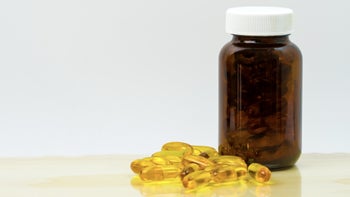
Omega-3 Dosages: How Much Should You Take Per Day, and How Much is Too Much?
Key takeaways:
It's not clear who should take omega-3 supplements and what the optimal omega-3 dose is. But if you or your child eat less than two to three servings of seafood a week, talk to your prescriber. They may recommend taking an omega-3 supplement.
Several health organizations recommend consuming 250 mg to 500 mg of DHA (docosahexaenoic acid) and EPA (eicosapentaenoic acid) combined per day. This may be from foods or supplements. Dosages of up to 5 g per day are generally considered safe in adults.
Research on whether omega-3 supplements have significant health benefits is mixed. But experts agree that getting omega-3s in your diet is vital for yours or your child’s overall health. The best food sources of DHA and EPA are oily fish, such as salmon, anchovies, and sardines.
Table of contents

You can find omega-3 fatty acids in many foods — oily fish, nuts, seeds, and more. You can also find them in over-the-counter (OTC) supplements. In fact, 1 in 5 adults over the age of 60 take an omega-3 supplement in the U.S.
If you’re thinking about taking an omega-3 supplement, you may be wondering what the best omega-3 dose is. The answer to this question is complicated, and it’s one that even experts can’t agree on. We’ll cover what we know here.
Good to know: Lovaza (Omega-3-Acid Ethyl Esters) and Vascepa (icosapent ethyl) are prescription omega-3 medications. They’re used to lower high triglyceride levels in adults. But we’ll only focus on OTC omega-3 supplements in this article.
First, what exactly are omega-3s?
Omega-3 is a type of polyunsaturated fat. Omega-3s have several functions in the body, such as providing energy to your cells and lowering inflammation. And they’re vital for the health of several organs, including the eyes, brain, and heart. There are several types of omega-3s, but the three main types are:
ALA (alpha-linolenic acid)
DHA (docosahexaenoic acid)
EPA (eicosapentaenoic acid)
ALA is an “essential” fatty acid. This means our bodies need ALA but can’t make it, so we need to get ALA from foods. Most people get enough ALA from the foods they eat. It’s mainly found in plant-based fats from nuts, seeds, and oils — including walnuts, flaxseed oil, and canola oil.
An organization called The National Academy of Medicine recommends specific daily intakes of ALA in adults and children. But it doesn’t make recommendations for DHA or EPA, which have the most known health benefits of all omega-3s.
Only small amounts of ALA are converted to DHA and EPA in the body (less than 15% of total ALA). That’s not enough to meet your needs. So you’ll need to eat foods or take supplements that contain DHA and EPA. The best food sources of DHA and EPA are oily fish, such as salmon, sardines, or anchovies.
How many milligrams of omega-3s should you get per day?
Most people in the U.S. aren’t getting enough DHA and EPA from their diets. And although there's no exact amount of omega-3s that all individuals should consume daily, several organizations have made recommendations regarding this:
The U.S dietary guidelines recommend that most adults consume 8 oz to 10 oz of seafood each week.
The American Heart Association (AHA) recommends 3 oz of cooked (not fried) fatty fish twice a week for heart health in most adults.
Several international health organizations recommend between 250 mg and 500 mg DHA and EPA (combined) per day for healthy adults. For specific recommendations from individual organizations, refer to this chart.
The FDA recommends eating 8 oz to 12 oz of fish per week from sources that are lower in mercury if you’re pregnant or breastfeeding. These include salmon, anchovies, and shrimp.
Several international health organizations recommend 250 mg of DHA and EPA combined through diet or supplements if you’re planning to become pregnant. They also recommend an additional 100 mg to 200 mg of DHA during pregnancy. Some people may need more, especially if they don’t eat any seafood.
If you’re using seafood to meet your DHA and EPA needs, how much you’ll get depends on what type of seafood you’re eating. For example, eating 6 oz of cooked, farmed salmon over the course of 1 week will give you about 3,600 mg of DHA and EPA combined. This would be equivalent to about 500 mg per day.
Eating the recommended amount of seafood each week can be hard to do, especially if you follow a vegan or vegetarian diet. In situations where you’re likely not getting enough DHA and EPA from food, taking an omega-3 supplement might be a good idea.
What’s the typical omega-3 dosage for adults?
Before you take an omega-3 supplement, talk with your prescriber and pharmacist. They’ll consider your current dietary pattern, medical history, and other medications you take when deciding whether to recommend an OTC omega-3 supplement.
Knowing what dose is best for you can be tricky because we don’t have exact recommendations for how to dose omega-3 supplements. However, research on the optimal omega-3 dose is expanding. We’ll summarize some key findings below:
General principles: The same omega-3 supplement dose can affect each individual differently. But higher omega-3 supplement doses typically lead to higher omega-3 blood levels for everyone. People with a lower baseline omega-3 level may need a higher supplement dose compared with someone with a higher baseline omega-3 level.
Heart health: People with certain health conditions may benefit from higher omega-3 supplement dosages (1,000 mg or more per day) than lower dosages (250 mg to 500 mg per day). This is because higher blood levels of DHA and EPA are correlated to decreased heart-related risks (such as heart attack and death) compared with lower blood levels of DHA and EPA. Still, the AHA doesn’t recommend OTC omega-3 supplements for people with existing heart disease. Its position is that available research doesn’t support the theory that OTC omega-3s prevent heart problems in people with existing heart disease.
High blood pressure: Some evidence shows that higher omega-3 doses (3,000 mg or more) may decrease systolic blood pressure (the top number) by 4 to 5 points.
Brain health: Omega-3 supplements may positively affect the brain, but research is mixed. Some studies show no effect on brain health, while others show improved brain structure and function. The best dose and optimal time in life to start omega-3 supplements for brain health aren’t known.
Inflammation: DHA and EPA can lower inflammation. And they may improve symptoms from autoimmune disorders such as rheumatoid arthritis (RA) when used along with prescription RA medications. For example, some research shows that higher omega-3 dosages (2.7 g daily or more) can lower RA symptoms in people taking methotrexate.
Other conditions: DHA and EPA supplements have been studied for several other health conditions, such as cancer, depression, and eye-related disorders. In general, the research on their usefulness for most health conditions is mixed.
As you can see, even large, well-designed studies show conflicting results when it comes to the benefits of omega-3 supplements, especially when it comes to possible heart benefits. Experts at the AHA don’t think there’s enough evidence to support the use of omega-3 supplements to prevent heart problems.
However, there’s still your overall health to consider. So, if you aren’t eating the recommended amount of seafood (particularly fatty fish) per week — somewhere between 6 oz and 10 oz, depending on which seafood source you’re eating — taking an omega-3 supplement may be useful. Some research indicates that consuming omega-3 supplements with 250 mg to 500 mg of EPA and DHA daily is enough to help you reap the general health benefits of omega-3s.
Still, until a target blood level of omega-3s is established, it’s hard to determine the exact omega-3 dosage that’s best for you. However, taking up to 5 g of DHA and EPA per day is generally safe, according to the FDA.
What’s the typical omega-3 dosage for children?
Omega-3 fats are especially important for children and their growing brains. And although omega-3 supplements have been studied for various health conditions — such as attention-deficit/hyperactivity disorder (ADHD), asthma, and more — supplementation isn’t usually recommended.
Here are some important things to know about omega-3s and children:
Many infant formulas contain DHA. If your baby drinks formula, check to see if their specific product contains it.
If you breastfeed, the FDA recommends consuming 8 oz to 12 oz of seafood per week.
Once your child starts eating whole foods, the FDA recommends two servings of low-mercury fish per week, such as salmon, cod, or tilapia. You can refer to this chart to learn which fish are best for children and what a typical serving size is based on your child’s age.
While omega-3 supplements aren’t usually recommended for children, talk to your pediatrician if your child doesn’t consume the recommended amount of seafood for their age (which is common, especially for picky eaters). In this case, your pediatrician may recommend an omega-3 supplement for your child.
Types of omega-3 supplements
There are several types of omega-3 supplements, including supplements made of:
Fish oil
Krill oil
Cod liver oil
Algae oil (vegan source of omega-3s)
Omega-3 supplements come in many forms, including pills, liquids and gummies. Different brands and formulations contain different amounts of DHA and EPA. Often, the front of the bottle will advertise total omega-3s per serving size.
But this can be misleading, because total omega-3s usually isn’t equivalent to the amount of DHA and EPA in each serving size. The amount of DHA and EPA per serving size is typically listed on the label (usually on the back of the bottle). Add up the amount of DHA and EPA to get the total amount of DHA and EPA combined.
Many types of omega-3 supplements should be taken with food to help them be absorbed. Make sure to read the label carefully, and ask your prescriber or pharmacist if you’re unsure about how much to take. And if the taste of fish oil bothers you, consider freezing the capsules. This can help reduce the fishy taste, without affecting their effectiveness.
Who shouldn’t take omega-3 supplements?
Anyone who's allergic to fish or shellfish needs to avoid taking products that contain fish oil or oil from shellfish, such as krill oil.
Additionally, make sure to talk to your health care provider (HCP) before trying an omega-3 supplement if you have any of the following conditions:
High cholesterol. Omega-3 supplements can increase levels of “bad” cholesterol (LDL).
Heart rhythm problems. Some research shows that higher doses of omega-3 may increase the risk of atrial fibrillation (AF), a type of abnormal heart rhythm. So if you’ve had heart rhythm problems in the past or you have heart disease, talk to your HCP before taking an omega-3 supplement.
High triglycerides. Only prescription omega-3s such as Lovaza and Vascepa are approved to treat high triglycerides. OTC omega-3s aren't considered acceptable substitutes for Lovaza and Vascepa.
How much omega-3 is too much?
As mentioned, taking up to 5 g of DHA and EPA per day is generally considered safe for healthy adults. But let your prescriber know if you accidentally take a larger amount at one time, or even if you just take an extra dose on accident. They can help you calculate exactly how much you took and provide further guidance. You can also call Poison Control at 1-800-222-1222.
The bottom line
It’s not clear who should take omega-3 supplements and what the optimal omega-3 dosage is. But the U.S. Dietary Guidelines recommend that adults eat between 8 oz and 10 oz of seafood per week. And the American Heart Association recommends at least 6 oz of fatty fish per week, such as salmon, anchovies, and sardines. Fish that’s low in mercury is the best option.
These recommendations are likely to help you reach, or exceed, the recommendation from several international health organizations to consume between 250 mg to 500 mg of DHA (docosahexaenoic acid) and EPA (eicosapentaenoic acid) combined per day. This can be from foods or supplements. For some people, doses higher than this may be needed for optimal health. Omega-3 dosages of up to 5 g per day are generally considered safe in adults.
Talk to your prescriber about whether they recommend taking omega-3 supplements, especially if you don’t consume any seafood.
Why trust our experts?



References
American Heart Association. (2022). About 3 grams a day of omega-3 fatty acids may lower blood pressure, more research needed.
Arthritis Foundation. (n.d.). Stop the fish oil aftertaste.
Assadourian, J. N., et al. (2023). Health claims and doses of fish oil supplements in the US. JAMA Cardiology.
Bernstein, A. S., et al. (2019). Fish, shellfish, and children’s health: An assessment of benefits, risks, and sustainability. Pediatrics.
Bhana, S. (2023). Diet considerations for those living with rheumatic illnesses. American College of Rheumatology.
Bos, D. J., et al. (2015). Reduced symptoms of inattention after dietary omega-3 fatty acid supplementation in boys with and without attention deficit/hyperactivity disorder. Neuropsychopharmacology.
Bradberry, J. C., et al. (2013). Overview of omega-3 fatty acid therapies. Pharmacy and Therapeutics.
Cetin, I., et al. (2024). Omega-3 fatty acid supply in pregnancy for risk reduction of preterm and early preterm birth. American Journal of Obstetrics & Gynecology MFM.
Flock, M. R., et al. (2013). Determinants of erythrocyte omega-3 fatty acid content in response to fish oil supplementation: A dose–response randomized controlled trial. Journal of the American Heart Association.
FoodData Central. (2019). Fish, salmon, Atlantic, farmed, cooked, dry heat. U.S. Department of Agriculture.
The Global Organization for EPA and DHA Omega-3s. (2014). Global recommendations for EPA and DHA intake.
Hahn, J., et al. (2022). Vitamin D and marine omega 3 fatty acid supplementation and incident autoimmune disease: VITAL randomized controlled trial. The BMJ.
Huh, J. H., et al. (2023). Omega-3 fatty acids and atrial fibrillation. The Korean Journal of Internal Medicine.
Krupa, K., et al. (2023). Omega-3 fatty acids. StatPearls.
Nagakura, T., et al. (2000). Dietary supplementation with fish oil rich in V-3 polyunsaturated fatty acids in children with bronchial asthma. European Respiratory Journal.
National Institute on Aging. (2023). What do we know about diet and prevention of Alzheimer's disease?
National Institutes of Health: Office of Dietary Supplements. (2023). Omega-3 fatty acids.
Satizabal C. L., et al. (2022). Association of red blood cell omega-3 fatty acids with MRI markers and cognitive function in midlife: The Framingham heart study. Neurology.
Stark, K. D., et al. (2016). Global survey of the omega-3 fatty acids, docosahexaenoic acid and eicosapentaenoic acid in the blood stream of healthy adults. Progress in Lipid Research.
Superko, H. R., et al. (2013). Omega-3 fatty acid blood levels. Circulation.
U.S. Department of Agriculture. (2020). Dietary guidelines for Americans, 2020-2025.
U.S. Food & Drug Administration. (2021). Advice about eating fish: For those who might become or are pregnant or breastfeeding and children ages 1 – 11 years.
U.S. Food & Drug Administration. (2023). Questions & answers for consumers concerning infant formula.
Vannice, G., et al. (2014). Position of the Academy of Nutrition and Dietetics: Dietary fatty acids for healthy adults. Journal of the Academy of Nutrition and Dietetics.
Veselinovic, M., et al. (2017). Clinical benefits of n-3 PUFA and ɤ-linolenic acid in patients with rheumatoid arthritis. Nutrients.
Virani, S. S., et al. (2023). 2023 AHA/ACC/ACCP/ASPC/NLA/PCNA guideline for the management of patients with chronic coronary disease: A report of the American Heart Association/American College of Cardiology joint committee on clinical practice guidelines. Circulation.
Walker, R. E., et al. (2019). Predicting the effects of supplemental EPA and DHA on the omega-3 index. The American Journal of Clinical Nutrition.
Williamson, L. (2023). Are you getting enough omega-3 fatty acids? American Heart Association News.
Was this page helpful?
Related Articles
Browse medications
View AllResearch prescriptions and over-the-counter medications from A to Z, compare drug prices, and start saving.




